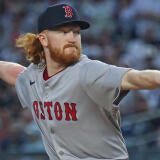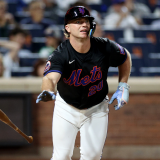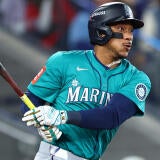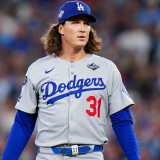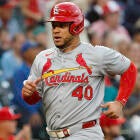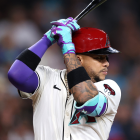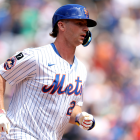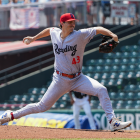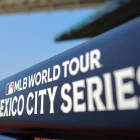MLB's best player at each uniform number -- from No. 1 Ozzie Smith to No. 99 Manny Ramirez and every digit in between
This list has legends ... and some vacant spots
Adam Ottavino made history when he signed with the Yankees.
Not by saying he would strike out Babe Ruth every time (though I would pay to see Ruth battle any of today's pitchers who throw high-90s fastballs with wipeout breaking pitches). No, what thrust Ottavino into the Yankees history book was the team's announcement that he would wear No. 0. When he takes the mound for the first time in the Bronx, he'll become the first Yankee ever to wear that number -- also the only single-digit number in franchise history that's not yet retired.
All that excitement over zero got me wondering: Who's the best player to ever wear a single bagel on his uniform? Who's the king of nil/nul/nol/cero/ziro/zewo/efes?
Turns out the career leader in Wins Above Replacement for players who wore No. 0 is Al Oliver, by a healthy margin. A seven-time All-Star, Oliver won three Silver Slugger awards, finished in the top 20 of MVP voting 10 times and in the top 10 three times. He collected 2,743 hits and 1,326 runs batted in over his 18-year career, good for 57th and 100th on the all-time lists. In his best season, as a 35-year-old playing for the Expos, he led the National League in batting average, hits, doubles, RBI and total bases. He's a long shot to ever make the Hall of Fame, but the same could have been said for Harold Baines, who just got in -- and Oliver was a better player than Baines.
The thing about baseball and numbers, though, is that it's hard to stop. Once you crown a winner for No. 0, you become curious about No. 10, and No. 50 and No. 97.
So here you go ... the top players at every number in major-league history, 1 through 99.
1 - Ozzie Smith
Arguably the greatest defensive player of all time at any position, Smith won 13 Gold Gloves and generated more than 37 Wins Above Replacement with his glove alone. Plus, there was this:

2 - Derek Jeter
Sixth all time in hits (3,465), 11th all time in runs scored (1,923), 12th in times on base (4,717), plus five rings in an era where dynasties are harder to come by than they've ever been.
3 - Babe Ruth
As a pitcher, Ruth went 94-46, won an ERA title, led the league once in shutouts, complete games, games started and fewest hits allowed per nine innings, and posted a career ERA 22 percent better than league average on a park-adjusted basis.
He was a pretty decent hitter too.
4 - Lou Gehrig
Mel Ott launched 511 homers, drove in 1,860 runs and was the best hitter in the league five times by advanced metrics. And he still can't get the nod here, because of the Iron Horse. In some ways, Gehrig's consecutive games streak, and playing alongside Ruth, might've slightly overshadowed the beastly hitter he was. Only Ruth and Ted Williams were better by OPS.
5 - Albert Pujols
This was the toughest call for any number. Here are just a few of the luminaries who didn't win for best No. 5: Joe DiMaggio, George Brett, Johnny Bench, Jeff Bagwell and Brooks Robinson. The first 11 years of Pujols' career make up one of the most prolific stretches for any hitter in major-league history. His decline as an Angel doesn't diminish his overall body of work, which is legendary.
6 - Stan Musial
A 20-time All-Star, Musial might've been the greatest metronome in baseball history. How else to explain compiling the exact same number of hits at home and away (1,815)? Not to mention his seven batting titles, and the most underrated stat in his gigantic résumé -- an astonishing 725 doubles.
7 - Mickey Mantle
A bit of Jimi Hendrix, Janis Joplin and Kurt Cobain lives in the Mantle mystique. Sure, he walloped 536 regular-season home runs, and hit an incomprehensible 18 long balls in 65 career World Series games, en route to winning seven rings. But we're talking about a player who by OPS+ rated as the seventh-best hitter of all time, yet had his career curtailed by injuries and other setbacks. Give him Hank Aaron's on-field health and far more off-field restraint, and The Mick might've ended up owning a whole bunch of all-time records.
8 - Joe Morgan
Another bruising competition, one that left Carl Yastrzemski, Cal Ripken Jr., Gary Carter, Yogi Berra and Willie Stargell on the cutting-room floor. But Morgan ranks right there with Rogers Hornsby and Eddie Collins in the battle for greatest second baseman of all time. If you took boxing's pound-for-pound rankings and made them an inch-by-inch baseball battle, the 5-foot-7 Morgan, winner of two MVP awards, maker of 10 All-Star Games and catalyst for the Big Red Machine dynasty, would be awfully tough to beat.
9 - Ted Williams
"A man has to have goals -- for a day, for a lifetime -- and that was mine, to have people say, 'There goes Ted Williams, the greatest hitter who ever lived.'"
10 - Lefty Grove
One of my favorite baseball debates of all time is also one you rarely hear mentioned: greatest left-handed pitcher of all time. It's an absolutely fascinating debate, though. Warren Spahn won more games than any other lefty. Sandy Koufax was Sandy Koufax, whose mythical six-year peak and World Series heroics to this day still make old-timers cast aside all objective analysis and declare their man the greatest, period. But by objective metrics such as Wins Above Replacement and Jay Jaffe's JAWS, the answer, by a hair, is Lefty Grove.
11 - Barry Larkin
I'll list MVP awards as worthy accolades here and there in this column, but with the caveat that it's an imperfect evaluation tool. Granting that Wins Above Replacement hadn't been invented yet back in 1995, the bottom line is that Larkin was the sixth-best player in the National League by that metric, and that if voters weren't so averse to picking pitchers as MVP, Greg Maddux would've won that year in a walk. At any rate, Larkin was one of the finest all-around shortstops of all time with or without that MVP award, and he's a worthy pick by an eyelash here over Edgar Martinez.
12 - Roberto Alomar
13 - Alex Rodriguez
Some of the greatest players of all time wore multiple numbers over the course of their career. A-Rod was one of the best of that bunch, sporting No. 13 in his 12 seasons as a Yankee after a decade of rocking No. 3 with Seattle and Texas. During those Yankees days he won two MVPs, socked 351 home runs, led the Bombers to a World Series title in 2009 and posted more Wins Above Replacement in that uniform alone than Tony Perez and Fred McGriff did in their entire careers.
14 - Pete Rose
On-field accomplishments considered only, which is how the lamentable Hit King tops Mr. Cub, Ernie Banks.
15 - Carlos Beltran
The criminally underrated center fielder was one of the most complete players of his generation, pairing an excellent batting eye with prodigious switch-hitter power and Gold Glove defense in center field to become a force well into his late 30s. Both Beltran and No. 15 runner-up Jim Edmonds have fascinating Hall of Fame cases. I would vote for Beltran and strongly consider Edmonds, but the voters might not end up giving the nod to either.
16 - Whitey Ford
The ace of the Yankees dynasties in both the 1950s and early '60s, Ford appeared in 11 World Series, won six, bagged a World Series MVP award and delivered a 2.71 ERA in 146 innings of Fall Classic work. His retirement didn't go as smoothly, as the great left-hander was mercilessly pelted with pretzels.
17 - Todd Helton
Dizzy Dean is the Hall of Famer of this bunch, but he earned that honor thanks in large part to his clinching Game 7 shutout in the 1934 World Series and his outsized personality. Helton still offers the better body of work, posting a career .414 on-base percentage with park-adjusted numbers better than Tony Gwynn, Joe Morgan or Jackie Robinson, busting the myth that he was merely a product of Coors Field.
18 - Johnny Damon
Damon set an example for Jacoby Ellsbury after him, starring for the Red Sox before defecting to the Yankees. Before his championship runs with both clubs, Damon formed one-third of one of the best outfields of the past several decades, teaming with Beltran and Jermaine Dye in Kansas City and making you wish those Royals teams had even half-decent supporting casts.
19 - Robin Yount
Snubbing both Tony Gwynn and Bob Feller is pretty rough. But Yount was that good, riding his MVP 1982 season to a Brewers AL pennant, winning another MVP seven years later, amassing 3,142 hits and becoming one of the few members of the 250 homers/250 steals club. Doing all that while manning two demanding up-the-middle positions at short and in center field bolsters his case even further.
20- Frank Robinson/Mike Schmidt (tie)
The 24th- and 25th-best players of all time by Wins Above Replacement (separated by a whisker). You try picking between the only player ever to win MVP in both leagues and the greatest third baseman of all time.
21 - Roger Clemens
The Rocket didn't even wear No. 21 for his entire career, and he has formidable competition in Roberto Clemente and Warren Spahn. But Clemens' numbers with the Red Sox and Blue Jays alone would make him an inner-circle Hall of Famer, if voters didn't choose to cherry-pick which performance-enhancing drugs from the pre-Joint Drug Prevention and Treatment Program era were ickier. Considering the pushover competition that pitchers like Cy Young and Walter Johnson faced in the days before integration or even organized farm systems, Clemens is my pick for greatest pitcher of all time.
22 - Clayton Kershaw
Kershaw's Koufaxian peak over Jim Palmer's longevity. That, and an excuse to tell the Clayton Kershaw Inception story.
23 - Ryne Sandberg
Ten straight All-Star Games, nine straight Gold Gloves, seven Silver Sluggers, an MVP award, a leading role in the snapping of a 39-year playoff drought and, of course, the Ryne Sandberg Game.
24 - Willie Mays
If No. 5 carried the slimmest margins between multiple candidates, No. 24 probably wins for sheer bad-assery. Here are the players who didn't get the nod for this number: Rickey Henderson, Ken Griffey Jr., Manny Ramirez, Miguel Cabrera and pre-Giants Barry Bonds. Then there's Mays, who wore No. 24 his entire career and is the third-best position player of all time.
25 - Barry Bonds
Forget about it! This one is headed for New Jersey!
I love Jon Miller. And I love Barry Bonds.
26 - Wade Boggs
Another Red Sox player who later defected to the Yankees, Boggs only wore 26 in his Boston days. Considering he hit .338 with a .428 on-base percentage, eight All-Star berths and seven Sliver Sluggers in those 11 seasons alone, that's plenty good enough.
27 - Scott Rolen
Of the four greatest players ever to wear No. 27, two are in the Hall of Fame, and two are not. Yet by Wins Above Replacement (Baseball-Reference version) Scott Rolen and Kevin Brown actually get the edge over Juan Marichal and Vladimir Guerrero, in substance if not in style. I'll take Rolen by a hair, if only to highlight what a strong Hall of Fame case he has, one that's currently being ignored. He's one of the two or three greatest defensive third basemen of all time along with Brooks Robinson and Adrian Beltre, and he's tied by OPS+ with the likes of Ernie Banks and Paul Molitor. Phenomenal, massively underrated player.
28 - Bert Blyleven
Pitched on some hellaciously lousy teams, but still Uncle Charlie'd his way to 3,701 strikeouts, 60 shutouts and, overcoming his frequently abysmal run support, more 1-0 shutouts than anyone in half a century.
29 - Adrian Beltre
Baseball is a game of reactions -- pitcher controls the ball, everyone else reacts to what happens next. For that reason, it's rare for a baseball player to have a signature move, the way, say, James Harden with the ball in his hands has perfected the stepback 3-pointer. But Beltre definitely had a signature move: the charging, bare-hand grab, followed by a rocket-armed, often off-balance throw to first to get the runner just in time. And while another No. 29 earned serious consideration here, Beltre doubled down by having mad hits (3,166) like he was Rod Carew (3,053).
30 - Tim Raines
Not at all a homer pick, Raines reached base more times than Tony Gwynn, Lou Brock, Roberto Clemente, Mike Schmidt, Roberto Alomar, Eddie Mathews, Brooks Robinson and Harmon Killebrew, is one of just five players ever to steal 800 bases, and owns the highest success rate for any base-stealer with anywhere near as many attempts.
31 - Greg Maddux
If we're going to downgrade the accomplishments of pre-integration (and Dead Ball ERA-adjacent) pitchers like Cy Young and Walter Johnson and anoint Roger Clemens as the greatest pitcher of all time, then Maddux has a strong case of No. 2 ... only without the alleged baggage that comes with Clemens' résumé. One of the greatest seasons of all time that doesn't get enough attention was mentioned earlier -- Maddux's '95 campaign. That year, Mad Dog flashed one of the lowest single-season ERAs ever recorded by a starting pitcher, 1.63. Except unlike Bob Gibson and others who toiled at such depths, Maddux pulled off his unreal season at the height of the PED era, in the process earning his fourth straight Cy Young honor.
32 - Steve Carlton
Apologies again to Sandy Koufax and his otherwordly 1961-66 peak, but Carlton was a master of longevity, pitching 24 years in the big leagues. He wasn't a mere compiler by any stretch, though. Lefty bagged five strikeout crowns and four Cy Youngs, the last one at the ripe old age of 37.
33 - Eddie Murray
For once, an easy call. Murray amassed 3,000 hits and 500 home runs back when both those numbers were immutable entry points into the Hall of Fame. If Mickey Mantle is the greatest switch-hitter of all time, Murray fits in comfortably with the likes of Pete Rose, Roberto Alomar, Tim Raines, Carlos Beltran, Bernie Williams and other all-timers.
34 - Nolan Ryan
The Ryan Express, all-time strikeout king, author of seven no-hitters, hawker of Advil, pitching iconoclast. He wore No. 34 his first two years with the Mets then didn't wear it again until 1980, his 14th year in the big leagues. You try fighting with him about it.
35 - Phil Niekro
The Big Hurt gets strong consideration here, but the nod goes to the greatest knuckleballer of all time. Like Tommy John, Jim Kaat, and other long-lasting pitchers, Niekro earned a bit of a reputation as a compiler, which can happen when you retire at 48(!). But Knucksie was a terror in his prime, even though his prime happened to come in his late 30s and on into his 40s: From 1977 through 1979, Niekro averaged more than 335 innings pitched and nearly nine Wins Above Replacement per year, clocking a ridiculous 65 complete games, a number that looked more like it came from decades earlier.
36 - Gaylord Perry
Speaking of crafty right-handers who pitched forever, this notorious spitballer pitched 22 years in the majors, winning his one Cy Young just past his 40th birthday. Baseball players cheat all the time, always have, always will. Might as well have some fun with it.
37 - Dave Stieb
One of the most underrated pitchers in baseball history, Stieb got jobbed by Hall of Fame voters, receiving just seven votes in his one and only time on the ballot. This despite posting better career numbers than his far more famous contemporary, Hall of Famer Jack Morris.
38 - Curt Schilling
You might expect specialists like Niekro and spitballers like Perry to post some of their best seasons well into their late 30s and past 40. You wouldn't necessarily expect it from a more conventional pitcher like Schilling. But Schilling's three Cy Young runner-up finishes came in his age-34, -35 and -37 seasons, and his five years leading the league in strikeout-to-walk rate happened at 34, 35, 36, 37 and 39. Basically, Schilling was a good pitcher who out of nowhere turned into a Hall of Fame-caliber pitcher, long past the age at which most conventional pitchers would decline.
39 - Hoyt Wilhelm
One of the game's first dominant relief aces, Wilhelm went 15-3 in his rookie season, firing 159 1/3 innings with a sparkling 2.43 ERA ... all out of the bullpen. He made his first major-league appearance at age 29 and his last at age 49, yet another oddity in his amazing Hall of Fame career.
40 - Bartolo Colon
41 - Tom Seaver
The Miracle Mets of 1969 probably aren't even the Mildly Interesting Mets if not for Seaver, who went 25-7 with a 2.21 ERA that year, winning his first of three career Cy Youngs. There are old-timey Mets fans who still count June 15, 1977, (the day the team traded Seaver to Cincinnati) as a day of mourning. Among pitchers who started their careers in 1900 or later, only Cy Young, Walter Johnson, Roger Clemens and Pete Alexander top Seaver in Wins Above Replacement.
42 - Jackie Robinson
Break the color barrier and lead the Dodgers to six NL pennants and one World Series victory, and it's only natural that people lose sight of smaller, more nuanced facts about Jackie Robinson. Like this: In his 10-year major-league career, Robinson walked 740 times and struck out just 291 times.
43 - Dennis Eckersley
Like John Smoltz and Hoyt Wilhelm, Eckersley built a solid body of work as a starting pitcher (149 wins, 3.71 ERA) to go with his lights-out performance as a bullpen stopper. Of the pitchers who built their reputations more or less entirely on standard one-inning closer work, only Mariano Rivera would get my Hall of Fame vote.
44 - Hank Aaron
The all-time leader in total bases and runs batted in, Aaron was not only great -- he was also incredibly durable. In the 16 seasons spanning 1955 through 1970, Aaron never played in fewer than 145 games, never hit fewer than 24 homers and never drove in fewer than 86 runs. Hammerin' Hank never hit more than 45 long balls in a season, but when you play that well and last for 3,298 games, the numbers will pile up.
45 - Bob Gibson
Feels like a crime to deny Pedro Martinez this spot, especially since Gibson built so much of his legend on the conditions of the second Dead Ball Era, the 1960s period that saw mounds built sky-high, spacious ballparks limit power, scrawny middle infielders and other banjo hitters make automatic outs and umpires gifting high-strike calls at will. Even with all those caveats, Gibson's 1968 season remains incomprehensible to this day.
46 - Andy Pettitte
An excellent pitcher and key cog in the Yankees' Core Four, Pettitte also made his mark as the highest-profile player of the 1990s and 2000s to get a free pass for his PED use. Being nice to the media has its advantages.
47 - Tom Glavine
On Aug. 5, 2007, Glavine banked his 300th win, becoming just the 23rd player to reach that milestone. Randy Johnson got to 300 two years later ... and that has been it. The advent of the five-man rotation made reaching 300 wins much more difficult, and the five-man has since given way to teams sometimes going to six-man rotations. Meanwhile, teams are yanking starters more quickly every year, recognizing both the third-time-through-the-order penalty against opposing hitters, and the availability of multiple live arms out of the bullpen who can come in fresh, firing 98 mph fastballs. While it's tough to say never about anything in baseball, it's possible that, absent big changes in the way pitchers are handled, we never see another 300-game winner again.
48 - Rick Reuschel
More Wins Above Replacement than Tim Raines, Manny Ramirez, John Smoltz, Jim Palmer, Eddie Murray, Tony Gwynn, Carlton Fisk, Ryne Sandberg and Ernie Banks, and there's a good chance that you've never heard of him. Reuschel won 214 games in his 19-year career, more than Smoltz, Don Drysdale or Sandy Koufax. He was one of the most corpulent pitchers in the league (especially later in his career), but also one of the best athletes, winning two Gold Gloves, popping up as both a pinch-hitter and pinch-runner and even legging out four career triples.
49 - Ron Guidry
His 1978 Cy Young-winning season was one of the most dominant by any pitcher over the past 50 years: a league-leading 1.74 ERA that netted a preposterous 208 ERA+, nine shutouts, just 6.1 hits allowed per 9 innings and, thanks in part to a killer Yankees team behind him, an eye-popping 25-3 record. His nickname, Louisiana Lightning, is an all-timer.
50 - Jamie Moyer
One of the most flammable pitchers in the league in his 20s, Moyer looked like he might wash out of baseball after spending the entire 1992 season in the minors. He returned to the big leagues the next year with vastly improved command, posting a stellar ERA 30 percent better than league average. He then lasted 18 more years in the majors, capping his 25-year career by becoming the oldest pitcher ever to win a game, doing so at age 49 and 150 days and breaking a record that had stood for 80 years.
51 - Randy Johnson
Lefty Grove barely edges Johnson by Wins Above Replacement for the honor of best left-hander ever. But when you consider that Johnson racked up more strikeouts than any other pitcher except Nolan Ryan, posted better fielding-independent numbers than Grove and dialed up his dominance during the off-the-charts-offense PED era, my pick is the Big Unit.
52 - CC Sabathia
One of the best and most durable pitchers of his era, Sabathia will reach $260 million in career earnings by the end of this season. If your kid is left-handed, supremely talented and incredibly hard-working, might be worth a go. Just sayin'.
53 - Bobby Abreu
Don Drysdale had a slightly better career, but I'm taking this opportunity to soapbox for Bobby Abreu. No matter how much we hear that a walk is as good as a hit, players tend to get recognized more for hits than walks. No matter how much we understand the gap between doubles and home runs, we tend to exaggerate that gap when evaluating how a player performed. Abreu was a terrific player who derived a lot of his career value from walks (1,476 of them, 20th all time) and doubles (574, 24th). Add in 400 stolen bases at a 76 percent success rate and terrific durability, and you have one of the best outfielders of his generation, someone worth real Hall of Fame consideration who in all likelihood won't even get a sniff from voters.
54 - Goose Gossage
Andrew Miller and Josh Hader emerging as unhittable, multi-inning weapons over the past few years harkens back to Gossage's prime. Though Goose did lead the league in saves three times, he was more of a true fireman than a one-inning, bases-empty, up-two-or-three closer, three times topping 130 innings of relief in a season and still averaging well over one inning per outing into his late 30s and early 40s. His views on millennials are comically dumb, but he was a helluva pitcher.
55 - Orel Hershiser
Yes, this was the moderate-offense era that preceded the hitting explosion of the '90s. Yes, Dodger Stadium played as one of the most pitcher-friendly parks in baseball. Yes, as best as we can quantify 30-plus years ago, the Dodgers were a good (but not elite) defensive team in 1988. Still, throw all those caveats in the trash so you can appreciate how impossibly difficult it is to fire 59 scoreless innings in a row. A lanky, bookish 17th-round draft pick might not be the image you conjure when thinking about pitchers who kept hitters up at night. But at his best, nobody gave opponents more nightmares than Hershiser did.
56 - Mark Buehrle
Buehrle earned a stellar reputation as a terrific control artist, an innings-eating bulldog, one of the quickest workers in the game and one of the best pitchers around. Still, when I hear the name Mark Buehrle, the first thing I think of is the perfect game he threw in 2009 ... and Dewayne Wise.
57 - Johan Santana
What a changeup this guy threw. And here are some more pitching goosebumps for ya:
58 - Jonathan Papelbon
A six-time All-Star who racked up 368 career saves, Papelbon is also one of the biggest hard-luck losers in the history of the Rookie of the Year award. In 2006, Papelbon marked his first full big-league season by striking out 75 batters and allowing just 40 hits and three home runs over 68 1/3 innings, recording 35 saves and a microscopic 0.92 ERA ... and lost anyway to Justin Verlander, who was good that year, but not that good.
59 - Carlos Carrasco
Sloughing off a series of shoulder problems as well as Tommy John surgery wiping out his entire 2012 season, Carrasco has emerged as one of the best pitchers in today's game that nobody talks about, probably because he shares a rotation with two-time Cy Young winner Corey Kluber and the ummm ... colorful right-hander Trevor Bauer. Since becoming a full-time member of Cleveland's rotation in 2015, Carrasco ranks third among all American League starters in strikeout rate and third in park-adjusted, fielding-independent pitching.
60 - Dallas Keuchel
Has a Cy Young Award and a reputation as one of the league's best and steadiest pitchers, which in this free-agent market should earn him a new contract around Labor Day, for about 14 cents.
61 - Livan Hernandez
The Cuban star enjoyed a productive 17-year major-league career, making two All-Star teams and three times leading the league in innings pitched. But if you ever want to anger a Braves fan of a certain age, just show them this:
62 - Scot Shields
A 38th-round draft pick making the majors, let alone emerging as one of the best relievers in the game for a few years, is damn impressive. Also, the other No. 62 under consideration is probably best known for bug spray.
63 - Ryan Madson
A short-lived and unsuccessful starter who found success in the bullpen, Madson is notable both for his strong performance (four seasons with an ERA of 2.55 or lower, including a dazzling 1.83 in 2017, plus two World Series rings) and resilience: After Tommy John surgery and numerous false starts, Madson actually retired in 2014, before re-emerging with the Royals after a three-year absence from the big leagues.
64 - Willians Astudillo
Sure, Astudillo has played just 29 games in the big leagues. But he's also a 5-foot-9, 225(???)-pound dynamo who batted .355 in his 29-game introduction to the Show. And then there's this:
I think you guys would enjoy this @jjcoop36 @jnorris427 😯 pic.twitter.com/wZpenI61xH
— Rafa Nieves (@mlb_agent) January 9, 2019
65 - James Paxton
Just 102 games into his major-league career, the Big Maple already has a no-hitter and an eagle on his résumé.
66 - Yasiel Puig
The Wild Horse will likely never regain the form that made him a phenomenon at the start of his career. He was deemed so expendable, the Dodgers simply dumped his salary on the Reds. But man, it sure was a fun ride for a while, wasn't it?
67 - Francisco Cordova
Cordova pitched two excellent seasons in the big leagues, highlighted by a 1998 campaign in which he twirled 220 1/3 innings with a 3.31 ERA, pitching in the same division as McGwire and Sosa during the year they went nuts on the league, no less. That alone is a pretty strong legacy.
68 - Dellin Betances
Struck out 42.3 percent of the batters he faced last season.
69 - Bronson Arroyo
Arroyo topped 200 innings eight times, won a Gold Glove and made an All-Star team. He just didn't do any of those things during the three seasons he wore No. 69 for the Pirates. Still, with so few players having donned that number, Arroyo is a nice pick.
70 - George Kontos
The higher the number, the more we're going to reach.
71 - Elmer Dessens
See No. 70.
72 - Carlton Fisk
Now we're talking. After making seven All-Star Games while donning No. 27 for the Red Sox, Fisk flipped the script when he changed his sox to white. I was barely a toddler when Fisk waved that walk-off homer in Game 6 just fair, but that didn't stop me from leaping and waving frantically at every single long drive in my backyard that needed to curl inside the balcony in left field to be a home run.
73 - Ricardo Rincon
The funniest part of the "Moneyball" movie (and possibly any movie) is that Jonah Hill's character would get this excited over Ricardo Freaking Rincon.
74 - Kenley Jansen
It's tough enough to hone your craft to the point where you become one of the most dominant relief pitchers of your generation. It's downright nuts to be able to do so while having not one but two heart surgeries.
75 - Barry Zito
One of my favorite pieces I've ever written was this appreciation for Oakland's Big Three of Tim Hudson, Mark Mulder and Barry Zito, as Hudson and Zito opposed each other in a career-ending start for both of them, at the Coliseum. I could give you 600 reasons why Zito was one of a kind. This, however, might be my favorite little nugget on the wildly successful left-hander:
Zito didn't play in 2014 — but mainly as a means of mental adjustment: "What became toxic for me was this idea, 'I have to succeed!'" Zito said. "Of course I want to succeed. But when you hold on to it too tight, it's like an egg. You squeeze too hard, and it breaks."
He then signed a minor league deal with Oakland this February and did something unprecedented for someone with his pedigree: Despite a Cy Young, two World Series rings, and a massive bank account, Zito accepted an assignment to Triple-A Nashville, then spent most of the year on the farm.
A burgeoning songwriter who calls Nashville one of his favorite cities for both its great music scene and overall fun vibe, Zito said he enjoyed his time in Tennessee. Still, some within the A's organization still can't believe what's happened.
"I said right off the bat in April: 'He's not really going to Triple-A if he doesn't make the team, is he?'" Forst said. "He had an out clause in his contract after spring training, but neither he nor his agent ever said anything. He just wanted to pitch so badly, he was fine with being in Triple-A. All the stories about middle seats on 6 a.m. flights, not complaining, just being one of the guys down there and everyone loving him … all of those stories are true."
76 - Jose Iglesias
... even though he only wore the number for one year, with the Red Sox. To atone for this paper-thin field at No. 76, here's a 2013 play by Iglesias that's still one of the best I've ever seen:
77 - Joe Medwick
Medwick only wore No. 77 for two seasons with Brooklyn. But he was a 10-time All-Star, the 1937 MVP and a Hall of Famer with a lifetime .324 batting average. Also, his nickname was "Ducky."
78 - Julio Urias
He doesn't even wear the number anymore, but I'm a sucker for pitching prospects who make their major-league debuts at a ludicrously young age, plus he's only 22 so there's lots of time for him to break out. Also, the specs are bad-ass.
79 - Jose Abreu
Abreu is a mighty fine player, a 6-3, 255-pound masher who has launched 146 homers in his first five big-league seasons, with a career line of .295/.353/.516. His list of accomplishments includes two All-Star appearances, two Silver Slugger awards and the 2014 American League Rookie of the Year. But he was even more fun back in Cuba, putting up video-game numbers with so few people watching, sparking pie-in-the-sky thoughts about his prodigious abilities. Very good major-league veteran is a great accomplishment; a slim but real chance he might be the best hitter in the world was even better, for the short time that lasted.
80 - N/A
According to Baseball-Reference, no major-league player has ever worn No. 80. So please enjoy some Jerry Rice highlights in the meantime.
81 - Eddie Guardado
For a few years, Guardado was one of the most reliable relievers in the American League. How a pitcher who led the league one time in appearances, and flashed a 5.25 ERA that season, would get the nickname "Everyday Eddie" is a mystery wrapped in an enigma.
82 - Johnny Lazor
Only one major-league player ever wore No. 82, and that one player was Johnny Lazor, a seldom-used outfielder for the Red Sox in the 1940s. On the plus side, "Johnny Lazor" is the best rejected superhero name of all time.
83 - Justin Turner
Before he became a Dodgers All-Star with one of the most lustrous beards of all time, Turner was a baby-faced rookie for the Orioles who experimented with obscure numbers. Related: Star bearded players always seem to have early-career stops with the Orioles, and always look completely, impossibly unrecognizable.
84 - Prince Fielder
Granted what I'm about to show you happened in Milwaukee, while Fielder wore a jersey with merely one-third the oomph of the No. 84 he wore in Texas. Still, any excuse to show the greatest walk-off celebration of all time is a good excuse.
85 - Lastings Milledge
The 12th overall pick in the 2003 draft was such a hot commodity coming up through the minors, Baseball America named him the ninth-best prospect in all of baseball. His career didn't amount to much, but beating out obscure pitcher Luis Cessa and even more obscure outfielder Che-Hsuan Lin is a pretty big deal nonetheless.
86 - N/A
87 - Dan Otero
According to Baseball-Reference, the second-most similar pitcher to Otero through age 33 is ... our entry for No. 70, George Kontos!
88 - Albert Belle
In his two seasons wearing No. 88 for the Orioles, Belle averaged 30 homers and 110 RBI. But degenerative hip osteoarthritis ended his career early, forcing the O's to keep him on the active 40-man roster for three years with no chance of him playing, because insurance companies are weird. Also, the sports world would be screwed without them.
89 - N/A
90 - Adam Cimber
A Padres relief prospect acquired by Cleveland as part of last summer's Brad Hand trade, Cimber saw his numbers crater with his new team, and he'll have work to do to make the big club this spring. Also, every time I hear his name I think of that Pitbull song and then can't get it out of my head all day. So now you get to suffer along with me.
91 - Alfredo Aceves
Along with Johnny Damon and Wade Boggs, we're apparently building an All-Star team of Red Sox-turned-Yankees, or in this case, Yankee-turned-Red Sock-turned Yankee.
92 - N/A
93 - Pat Neshek
A 12-year major-league veteran, Neshek didn't don No. 93 until last season, his second tour of duty with the Phillies. Neshek is an extreme side-armer who's a rabid baseball card collector and a huge fan of The Simpsons. You'll be shocked to learn that he has been one of my favorite players from day one of his career.
94 - Jose Mesa
What is it about relievers choosing defensive lineman numbers late in their careers? In Mesa's case, it happened in his final season, during a 16-game stopover with the Tigers. If you want to know everything there is to know about the volatility of closers, go ask fans of the 1995 Cleveland team and fans of the 1999 Mariners the same question: What do you think of Jose Mesa? Come to think of it, ask fans of the 1995 Cleveland team, and the same Cleveland fans who watched Mesa in Game 7 of the 1997 World Series that same question, and see what happens.
95 - Takahito Nomura
Nomura was a 5-7, 175-pound, 33-year-old rookie for the 2002 Brewers. He appeared in 21 games, threw 13 2/3 innings, walked 18 batters and delivered an 8.56 ERA, then never pitched in the big leagues again. But you know what? He still made it, man. He made it.
96 - Bill Voiselle
Voiselle pitched from 1942 to 1950 with the old New York Giants, Boston Braves and the Cubs, and looked pretty good doing it for a while: In 1944 he led the National League in strikeouts and innings pitched, won 21 games and made the All-Star team. And if you're wondering why a pitcher in the '40s would take such a weird uniform number, the answer is simple: Voiselle hailed from the town of Ninety-Six, South Carolina, where he attended Ninety-Six High School, paving the way for his future nickname and uniform number, ninety-six.
97 - Joe Beimel
The only player in major-league history ever to wear No. 97. So he's the winner by default, the two sweetest words in the English language.
98 - Onelki Garcia
Another cup-of-coffee players, Garcia pitched 1 1/3 innings for the 2013 Dodgers, then returned four years later to hurl six frames for the 2017 Royals, in both cases putting up a 13.50 ERA.
99 - Manny Ramirez
Remember when the Dodgers used to go after fun, flashy players who could put butts in seats? That was Manny, who even late in his career could still rake, rocking No. 99 in L.A. for three seasons. This winter, armed with all the money in the world to get anyone they wanted, they signed ... A.J. Pollock. Boo.
It's worth noting that Mike Trout and Aaron Judge obviously have strong arguments for 27 and 99, respectively, but I wanted to make a point about how ridiculously good Rolen and Manny were in their primes.It'll be interesting to see where they sit on this list once their careers come to a close.


